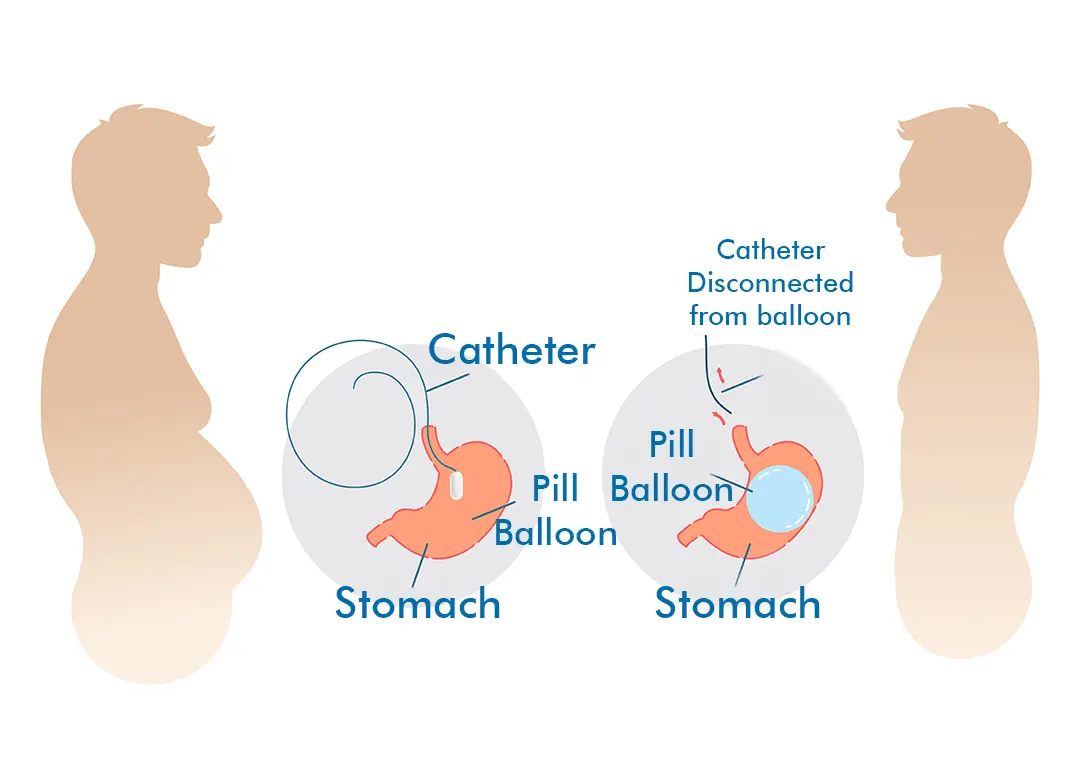

Bariatric Surgery
Weight-loss and gastric bypass are collectively known as bariatric surgery or weight loss surgery that involves making changes in the digestive system for weight loss. People usually go for bariatric surgery when exercise and diet don’t work and have obesity problems. The surgery is done in cases where diet and exercise does not work. These procedures work by reducing the nutrient absorption ability of the body, it alters the digestion process so that the food doesn’t break down completely.
Body Mass Index (BMI) is used to determine thelevel of obesity in relation to height to weight. BMI over 35 or 45 kg/m2 describes severe health problems. Bariatric surgery is done to help people to reduce the risk of developing life-threatening health diseases like heart disease and stroke, Type 2 diabetes, sleep apnea, high blood pressure and non-alcoholic fatty liver disease caused by excess weight.
Obesity Surgery
Obesity involves the accumulation of the excess amount of fat in the body with negligible weight loss. A person has to make efforts to lose weight like eating less and exercising but in some cases shedding weight for some overweight people is tougher than usual. When diet and exercise don’t solve the problem, the doctor performs obesity surgeries to reduce the life-threatening risks. People with malabsorptive surgeries lose two-thirds of their excess weight within two years.
Symptoms
Symptoms of obesity have negative effects on a person’s daily life. The more overweight a person is, the more he is prone to develop medical conditions related to obesity. If you are obese, you may experience the following:
- Coronary artery disease
- Breathing disorders (chronic obstructive pulmonary disease, sleep apnea)
- Excess body fat accumulation
- Fatigue from mild to extreme
- Pain commonly in joints and back
- Sweating more than usual
- Depression
- Gallbladder or liver disease
- High blood pressure
- High cholesterol
- Diabetes
- Stroke
- Varicose veins
- Reproductive system disorders
Causes of obesity can be genetic, behavioural, hormonal and metabolic. A person becomes obese due to the high intake of calories and less physical activity. In such conditions, the body starts storing calories in the form of fat, increasing the body weight.
Diagnostic Tests
Diagnostic tests are required for complete optimization of the patients before the surgery. The tests allow us to provide the patient with the best weight loss solution available. Following tests are required prior to the surgery :
- EKG
- CXR
- Thyroid function test
- Blood test
- Cardiac echo
- Stress test
- Endoscopy and upper GI
Other tests can be asked by the bariatric surgeon depending upon the condition of the patient.
TREATMENT
Now the question arises, how to lose weight? A person can go for obesity treatment such as non-surgical weight loss methods initially but in cases where the results don’t meet the expectations, obesity surgery is the only option.
The non-surgical weight loss treatment includes being physically active for calorie burning, a healthy diet, weight management programs and weight loss medicines
Surgical options include Rou-ex-Y gastric bypass, Sleeve gastrectomy, Bariatric Revision Surgery and Endoscopic balloon insertion.
Gastric Bypass
Gastric bypass surgery is a non-reversible weight loss surgery where the amount of food eaten decreases and reduces nutrient absorption. The surgery will re-route part of your digestive tract, reducing the absorption of food.
Gastric bypass surgery can be done in two ways -
Open surgery is done by making large surgical cuts in the stomach.
Laparoscopic surgery is done with the help of a tiny camera that allows the surgeon to see inside the belly.
The surgeon cuts across the top of the stomach, sealing it from the rest resulting in the size of a walnut that holds about 3 pints of food. This pouch is connected with the small intestine and the food is directly transferred to the small intestine sewn to it. The stomach will be smaller after the surgery and feel full with less food.

Advantages of laparoscopic surgery over open surgery :
- Fast recovery and less pain
- Shorter stay at the hospital
- Less scarring and low risk of hernia or infection
Risks of Gastric Bypass Surgery
Though gastric surgery helps in weight reduction but has many risks involved. Some of the risks are serious and can affect health permanently. The risks for gastric bypass are:
- The stapes breakdown and fall apart
- The stomach gets bigger over time due pouch stretching back to its original size.
- Vitamin, mineral and nutrient deficiencies due to less absorption from food.
- Stomal stenosis
- Dumping syndrome
Sleeve Gastrectomy
Sleeve Gastrectomy or Vertical Sleeve Gastrectomy is a laparoscopic weight loss where 80 per cent of the stomach is removed and reduces the production of ghrelin (appetite-regulating hormone) lessening the desire to eat. This procedure results in significant weight loss and no rerouting of the intestine. The surgeon creates a small stomach sleeve by using laparoscopic staplers and the rest of the stomach is removed. The thin sleeve is about the size of a banana, causing significant weight loss by giving the feeling of fullness faster

What to expect during the surgery︖
- The surgeon makes 2-5 incisions in the stomach.
- The instruments required during the surgery are inserted through the cuts.
- The camera connected to the monitor allows the surgeon to have a view of the inside belly.
- A harmless gas is pumped into the belly for its expansion giving more area for surgery.
- Most of the stomach is removed through surgery.
- The remaining stomach is joined together by surgical staples.
- The surgery doesn’t involve changing the sphincter muscle, allowing the easy flow of food inside and outside the stomach.
- The surgery lasts for 60-90 and tools are removed
Advantages of Sleeve Gastrectomy
- The surgery cause changes in the gut hormone that suppress hunger and eliminates the production of ghrelin.
- The procedure is non-reversible as one part of the stomach is permanently removed. The remaining part can dilate the need for overeating.
- It restricts the amount of food eaten thus, leading to weight loss.
Risks involved in Sleeve gastrectomy
Sleeve gastrectomy is a great option for weight loss but there are some risks involved:
- Allergic reactions to medicine
- Infection and bleeding
- Respiratory problems
- Poor nutrition (less than gastric bypass surgery)
- Scarring inside the belly
- Stomach ulcers
- Gallstones
Gastric Balloon Insertion
Gastric Balloon Insertion is a non-surgical procedure done with the help of an endoscope. It involves the placement of a saline-filled silicone balloon in the stomach via the throat using a catheter. The weight loss balloon or gastric balloon fills most parts of the stomach and helps in limiting the intake of food by making you feel fuller faster. It is a reversible procedure that allows fluid evacuation, deflation and removal of the balloon. Stomach balloons are left in place for six months and are removed later using an endoscope.
Another option is an eclipse balloon which comes in theform of a capsule. The surgeon will as you to swallow the capsule attached to a thin catheter with water. An X-ray confirms the proper placement of the capsule by the doctor.The vegetarian capsule degrades and the balloon starts filling up with 550 mL of water. A second X-ray is done to ensure the filling of the balloon and after this, the catheter is removed. This is a non-invasive 20 minutes procedure.

It is not the right choice for everyone who is overweight. An endoscopic balloon insertion is an option for you, if:
- You’re willing to make healthy lifestyle changes and participate in behavioural therapy.
- Your body mass index (BMI) is between 30 and 40.
- You have not undergone any stomach and esophageal surgery
Bariatric Revision Surgery
Revision weight loss surgery is performed when a person has already undergone any form of bariatric surgery and did not achieve the required results or faces any form of complications or side effects because of the surgery.In revisional bariatric surgery, the surgeon repairs or modifies the previous operations. If a person has the underlisted condition, then than he is a suitable candidate for revision bariatric surgery.
- Malignancy
- Dumping Syndrome
- Excessive vomiting
- Loose stools
Adam Vital Hospital has the best Bariatric and MetabolicSurgery Centre in Dubai with the availability of advanced technologies and an excellent team of weight loss surgeons. Consult our expert Dr Nizam Alrifai, Specialist General and Bariatric Surgeon for the best medical assistance and bariatric surgeries.


